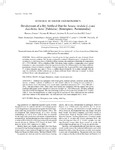Use este identificador para citar ou linkar para este item:
http://www.alice.cnptia.embrapa.br/alice/handle/doc/469683Registro completo de metadados
| Campo DC | Valor | Idioma |
|---|---|---|
| dc.contributor.author | FORTES, P. | pt_BR |
| dc.contributor.author | MAGRO, S. R. | pt_BR |
| dc.contributor.author | PANIZZI, A. R. | pt_BR |
| dc.contributor.author | PARRA, J. R. P. | pt_BR |
| dc.date.accessioned | 2011-12-09T00:00:34Z | - |
| dc.date.available | 2011-12-09T00:00:34Z | - |
| dc.date.created | 2006-11-06 | pt_BR |
| dc.date.issued | 2006 | pt_BR |
| dc.identifier.citation | Neotropical Entomology, Piracicaba, v. 35, n. 5, p. 567-572, Sep./Oct. 2006. | pt_BR |
| dc.identifier.uri | http://www.alice.cnptia.embrapa.br/alice/handle/doc/469683 | pt_BR |
| dc.description | Artificial diets prepared with wheat germ, soybean protein, dextrosol, potato starch, sucrose, cellulose, soybean or sunflower oil, and vitamin solution for rearing Nezara viridula (L.) and Euschistus heros (Fabricius) were tested under controlled temperature +- 1°C), RH (60 +- 10%), and photophase (14h). Three diets were tested and compared with the natural diet privet [soybean and peanut seeds and privet Ligustrum lucidum Ait. fruit (Oleaceae)]. All three artificial diets allowed full development. The diet containing sunflower oil was the most suitable for N. viridula while E. heros developed better on a diet composed of soybean oil. Data indicated that the artificial diets were inferior to the natural diet. The artificial diets were more adequate for E. heros. | pt_BR |
| dc.language.iso | eng | eng |
| dc.rights | openAccess | eng |
| dc.title | Development of a dry artificial diet for Nezara viridula (L.) and Euschistus heros (Fabricius) (Heteroptera: Pentatomidae). | pt_BR |
| dc.type | Artigo de periódico | pt_BR |
| dc.date.updated | 2011-12-09T00:00:34Z | pt_BR |
| dc.subject.thesagro | Entomologia | pt_BR |
| riaa.ainfo.id | 469683 | pt_BR |
| riaa.ainfo.lastupdate | 2011-12-08 | pt_BR |
| Aparece nas coleções: | Artigo em periódico indexado (CNPSO)  | |
Arquivos associados a este item:
| Arquivo | Descrição | Tamanho | Formato | |
|---|---|---|---|---|
| 26773.pdf | 405.09 kB | Adobe PDF |  Visualizar/Abrir |









